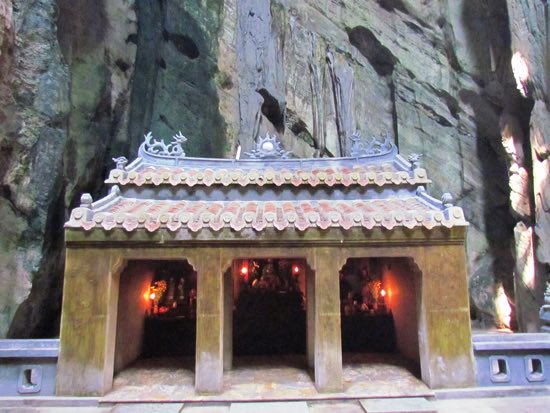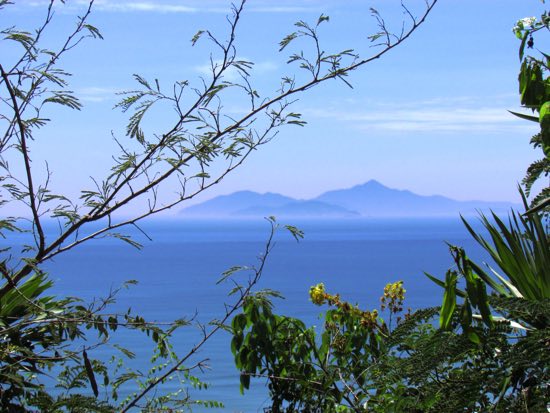The Marble Mountains have been extensively developed and promoted as a tourist attraction, but the haunting beauty of the spot makes it easy to forget you’re part of a crowd.
- Place to visit in vietnam danang
It’s an essential stop if you’re in the area. The mountains are comprised of five limestone outcrops in isolation from the surrounding plains, each riddled with caves and grottos, with some made into pagodas and shrines. Each mountain represents one of the five elements of the universe: water, wood, fire, metal and earth. The main mountain, representing water, has a path to the top with two entrances open to tourists. There is a 15,000 VND entry fee at the base of a very long flight of stairs. You can also enter from the second entrance, farther down the road, which is a much less strenuous climb, though most visitors feel the attractions ‘flow’ better if you start from the steps. If the long climb sounds daunting, there is now a glass observation elevator that will take you up the 43 metres to the main pagoda for 15,000 VND each way. The top offers spectacular views of Da Nang and the surrounding Marble Mountains. A better vantage point is reached through a small hole at the top Heaven’s cave, with the views including Non Nuoc beach, the Son Tra Peninsula and Cham Islands.
Some of the larger caves have been transformed into religious shrines, with Buddha statues built within them along with all the associated guardians. Some are quite eerie with the pungent smell of incense wafting in the air and the walls pocked by bullets from small arms fighting during the American war, when cave-to-cave battles occurred here. In Huyen Khong cave, one of the large holes in the ceiling was caused by a bomb. Within this cave there are a number of shrines, temple guards and Buddha statues, and there are still stalactites on the ceiling. Off to the side of the cave there are two small stalactites believed to represent breasts. One is dripping while the other is dry. According to legend, when Emperor Tu Duc entered and touched one of the stalactites, it stopped dripping and never has since.
Visiting either early morning or evening offers relief from the heat; after 17:00, they stop charging admission and you can watch the sun set from the mountain — though bring a flashlight for the trip down, and you must be fairly surefooted to make it without breaking your neck. The real highlight of the caves however is the light streaming into the caverns through the incense-laden air from the openings above. Great for pictures, this only happens however between 10:00 and 14:00. Our advice is to go in the middle of the day and sweat it out as you can seek out one of the cool caverns for relief between trips out into the blazing sun.

Another tip is to fork out the extra 15,000 VND at the ticket office and buy a map routing out the access paths to the other less visited (and in turn less developed) smaller mountains. It’s likely you will have them all to yourself.
- Read more: vietnam travel guide
For those that think stairs are for wimps, Phat Tire Ventures organise half-day rappelling and rock climbing for all levels on the Marble Mountains, where you can climb up or repel down the karst wall into a couple of the caves. The best one is a 50-metre drop out of the jungle into a gaping dark hole eventually landing up in a small temple chamber. Equipment and guides are excellent and they also have a few programmes suitable for kids.
At the base of the Marble Mountains is Non Nuoc hamlet, which is crowded with around a hundred stone carving shops and is very reminiscent of India’s Mahalliburipuram, with the relentless, piercing sounds of stone being sawn into chunks and endlessly chipped away at. Luckily they realised that the mountains would disappear if they kept lopping pieces off it, so most of the marble is now imported from elsewhere. Many of the statues are impressively massive and exquisitely detailed and you can watch the craftspeople at work.

If your pack isn’t big enough for a ten-foot high temple dog, they do have some very tasteful, smaller carvings although an awful lot of these are made from either resin or powder. The best way to tell is by giving it a good shake (powder) and testing the temperature – real marble will be cold to the touch. Competition is fierce among shop owners so haggle hard for the best price.
- Read more: Top 10 places to go outside vietnam hanoi


















0 nhận xét:
Đăng nhận xét